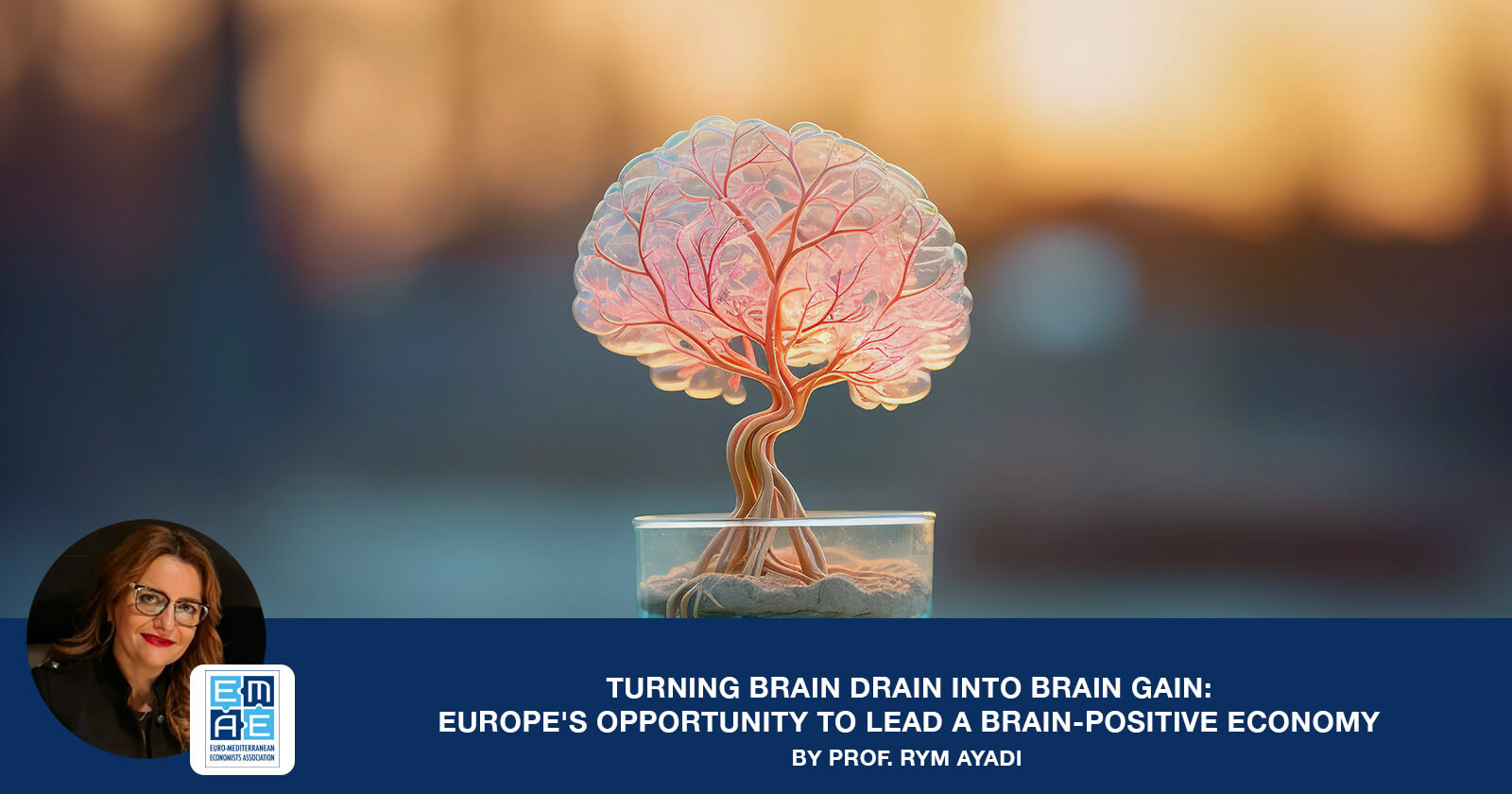By Prof. Rym Ayadi, Founder and President of Euro-Mediterranean Economists Association (EMEA)
Brain Capital is a comprehensive framework that positions brain health and brain skills as critical assets for economic growth and wellbeing, societal resilience, and innovation. It emphasizes the interplay between mental well-being, cognitive capacity, and technological advancements, advocating for investments that enhance human potential and unlock sustainable development opportunities.
Brain Capital can become the lever to transform brain health from a societal cost into a strategic investment by reframing brain health as an essential asset for economic growth and wellbeing, resilience, and innovation. This shift involves integrating brain health into public policy, business strategy, and societal frameworks to unlock its vast potential to drive productivity, reduce economic and social burdens, and foster inclusive development.
The following recommendations for this shift:
1. Recognizing Brain Health as Economic Infrastructure
Brain health issues, including mental health disorders and neurodegenerative diseases, are projected to cost the global economy $6 trillion annually by 2030 (According to the World Economic Forum). By viewing brain health as critical infrastructure, akin to physical infrastructure, investments can be redirected from reactive spending solely based on treatment to proactive initiatives that include prevention, education, and innovation.
This perspective treats brain health as a foundational element of economic systems. Just as investments in roads, bridges, and technology drive economic growth, investing in brain health infrastructure—such as accessible mental health services, community support systems, and public awareness campaigns—can enhance population health, workforce performance and economic resilience. For example, proactive programs to promote mental health resilience in workplaces can boost productivity while reducing absenteeism and healthcare costs. Early diagnostic systems of brain disorders can be integral part of primary care…
2. Leveraging Advances in Neuroscience and Technology
Innovations in neurotechnology and data science provide unprecedented opportunities to address brain health challenges. By investing in these tools, Brain Capital can be enhanced, through the acceleration of early diagnosis, personalized interventions, and scalable mental health solutions.
Advances such as brain-computer interfaces, neuroimaging, and AI-driven analytics are transforming how we understand and manage brain health. These technologies enable not only early detection of issues but also continuous monitoring, predictive analytics, and tailored interventions that align with individual needs, enhancing both care quality and efficiency.
For example, digital mental health platforms using AI for real-time support and diagnostics can make care more accessible and reduce costs, particularly in underserved regions.
3. Integrating Brain Health into Education Systems
Education systems that emphasize emotional intelligence, cognitive skills, and resilience help build Brain Capital from an early age, reducing future societal costs associated with mental health issues.
Embedding brain health education into school curricula fosters a generation equipped with tools to manage stress, build emotional resilience, and develop critical thinking skills. Early interventions through structured programs can mitigate long-term societal costs by reducing the prevalence of mental health issues and boosting overall cognitive performance.
For example, social and emotional learning (SEL) programs in schools not only enhance students’ cognitive abilities but also lower the likelihood of mental health disorders later in life.
4. Redefining Brain Health Metrics as Investment Outcomes
Shifting the narrative requires adopting metrics that highlight the returns on investment (ROI) in brain health. Tools like Mental Health-Adjusted Life Years (MHALYs) can demonstrate the economic and societal gains of improved brain health.
Traditional metrics often fail to capture the full scope of brain health’s impact. Introducing innovative metrics—such as Brain Health ROI indices and MHALYs—provides a clearer picture of how investments translate into tangible economic and social benefits, making a compelling case for prioritization in policy and funding.
For example, studies show that for every $1 invested in mental health treatment, there is a $4 return in productivity and societal well-being according to WHO.
5. Promoting Public-Private Partnerships
Collaborations between governments, businesses, and academic institutions can amplify the impact of brain health investments, ensuring scalable and sustainable solutions.
Public-private partnerships enable pooling of resources, expertise, and innovation. Governments can provide regulatory frameworks and funding, businesses can offer practical applications and scalability, and academic institutions can contribute cutting-edge research and validation, creating a synergistic approach to addressing brain health challenges.
For example, corporate wellness programs that integrate mental health support have been shown to enhance employee retention and innovation.
6. Aligning Brain Health with Broader Societal Goals
Brain health must be positioned as a critical enabler of broader economic and societal transitions, including the digital and green transitions. Healthy, adaptive minds are essential for navigating complex global challenges.
As societies face unprecedented challenges such as climate change and technological disruption, brain health becomes a strategic asset. Healthy minds are better equipped to innovate, adapt, and collaborate, driving progress in critical areas such as renewable energy, sustainable urban planning, and ethical AI development.
For example tailored programs that drive innovation in green technologies and circular economies by fostering creativity, problem-solving, and collaborative thinking.
7. Encouraging Inclusive Policies and Access
Inequities in access to mental health care disproportionately affect marginalized populations, compounding societal costs. Policies that expand access to brain health resources create more equitable opportunities and reduce long-term economic burdens.
Inclusive policies ensure that vulnerable groups—such as low-income populations, refugees, and rural communities—receive adequate support. Expanding access through initiatives like mobile mental health clinics, telemedicine, and subsidized care not only improves individual outcomes but also strengthens societal cohesion and economic potential.
For example, community mental health initiatives in low-income regions address inequalities while enhancing local economic productivity.
Brain capital concept can transform brain health from a societal cost into a strategic investment by prioritizing prevention, innovation, and inclusion. This shift not only alleviates economic burdens but also unleashes the full potential of individuals to contribute meaningfully to their communities and economies. By embedding brain health into the core of societal and economic strategies, we can create a future where mental well-being fuels growth, resilience, and shared prosperity.
Prof. Rym Ayadi, EMEA President, and co-founder of the Brain Capital Alliance, delivered the keynote speech “Transforming brain health into a strategic investment through brain capital” at the 2nd Stakeholder Meeting of the Swiss Federation of Clinical Neuro-Societies (SFCNS) Swiss Brain Health Plan. 05 December 2024, at the Zentrum Paul Klee, in Bern, Switzerland.
For more info: EMEA President, Prof. Rym Ayadi, presents Brain Capital at the 2nd Stakeholder Meeting of the SFCNS Swiss Brain Health Plan





